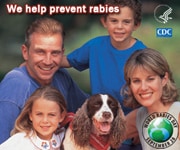Rabies Postexposure Prophylaxis (PEP)
What medical care will I receive if I may have been exposed to rabies?
Postexposure prophylaxis (PEP) consists of a dose of human rabies immune globulin (HRIG) and rabies vaccine given on the day of the rabies exposure, and then a dose of vaccine given again on days 3, 7, and 14. For people who have never been vaccinated against rabies previously, postexposure prophylaxis (PEP) should always include administration of both HRIG and rabies vaccine. The combination of HRIG and vaccine is recommended for both bite and non-bite exposures, regardless of the interval between exposure and initiation of treatment.
People who have been previously vaccinated or are receiving pre-exposure vaccination for rabies should receive only vaccine.
Adverse reactions to rabies vaccine and immune globulin are not common. Newer vaccines in use today cause fewer adverse reactions than previously available vaccines. Mild, local reactions to the rabies vaccine, such as pain, redness, swelling, or itching at the injection site, have been reported. Rarely, symptoms such as headache, nausea, abdominal pain, muscle aches, and dizziness have been reported. Local pain and low-grade fever may follow injection of rabies immune globulin.
The vaccine should be given at recommended intervals for best results. Talk to your doctor or state or local public health officials if you will not be able to have your shots at the recommended interval. Rabies prevention is a serious matter and changes should not be made in the schedule of doses. Patient assistance programs that provide medications to uninsured or underinsured patients are available for rabies vaccine and immune globulin.
People cannot transmit rabies to other people unless they themselves are sick with rabies. PEP will protect you from developing rabies, and therefore you cannot expose other people to rabies. You can continue to participate in your normal activities.
Information for Clinicians
See our information on rabies biologics for information on dosing and administration route. You can also consult with local or state health officials for recommendations for assistance with risk assessments and PEP recommendations.
Regardless of the risk for rabies, bite wounds can cause serious injury such as nerve or tendon laceration and infection. Your doctor will determine the best way to care for your wound, and will also consider how to treat the wound for the best possible cosmetic results.
For many types of bite wounds, immediate gentle irrigation with water or a dilute water povidone-iodine solution has been shown to markedly decrease the risk of bacterial infection.
Wound cleansing is especially important in rabies prevention since, in animal studies, thorough wound cleansing alone without other postexposure prophylaxis has been shown to markedly reduce the likelihood of rabies.
You should receive a tetanus shot if you have not been immunized in ten years. Decisions regarding the use of antibiotics, and primary wound closure should be decided together with your doctor.

